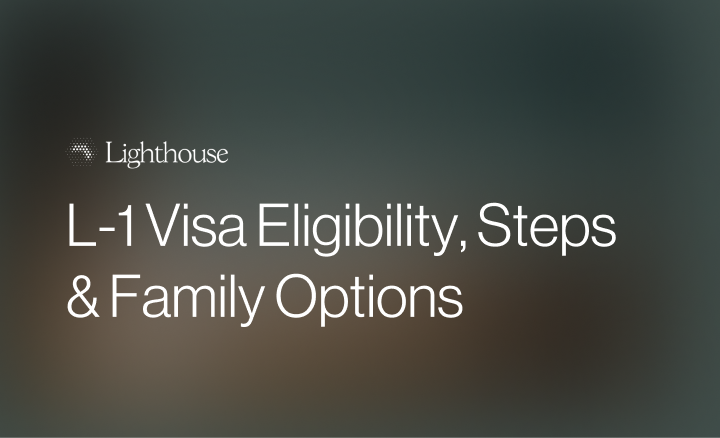Form I-129 Explained
Everything you need to know about Form I-129 for nonimmigrant worker petitions.


If you're an employer looking to hire foreign talent in the United States, Form I-129 is the document that makes it possible. This comprehensive guide breaks down what Form I-129 is, which visa categories require it, and the complete filing process from start to finish.
What is Form I-129 and why it matters
Form I-129 (Petition for a Nonimmigrant Worker) is the official USCIS form employers use to request permission to hire foreign workers in temporary visa categories. This petition establishes that both the employer and the prospective employee meet the requirements for a specific nonimmigrant status under U.S. immigration law.
The form serves as the legal foundation for most employment-based temporary visas. Without an approved I-129, foreign workers cannot obtain work authorization in the United States. The petition demonstrates to USCIS that the job is legitimate, the employer can pay the required wages, and the foreign worker possesses the necessary qualifications.
Your role as the petitioner is crucial. You are not simply completing paperwork. You are making a legal declaration that you'll comply with all terms of employment and visa requirements. The beneficiary (your prospective employee) depends on the accuracy and completeness of your petition for their visa application.
Filing errors or incomplete documentation can delay cases for months and create significant stress for both employers and workers. Careful preparation reduces these delays and helps ensure successful outcomes.
Visa categories that require Form I-129
Form I-129 covers the majority of employment-based nonimmigrant visa classifications. Each category has specific requirements and uses a corresponding classification supplement attached to the main form.
H classifications include H-1B specialty occupation workers, H-1B1 professionals from Chile and Singapore under free trade agreements, H-2A seasonal agricultural workers, H-2B non-agricultural workers, and H-3 trainees. H-1B petitions require a certified Labor Condition Application from the U.S. Department of Labor before filing.
L classifications cover L-1A executives and managers, and L-1B workers with specialized knowledge being transferred from foreign offices to U.S. locations. These intracompany transferee positions require the employee to have worked for a related company abroad for at least one year in the past three years.
O classifications include O-1A individuals with extraordinary ability in sciences, arts, education, business, or athletics, O-1B artists and entertainers with extraordinary achievement, and O-2 support personnel. O-1 petitions require advisory opinion letters from appropriate peer groups or labor organizations.
P classifications cover P-1 individual and team athletes and entertainers, P-2 artists in reciprocal exchange programs, and P-3 artists in culturally unique programs. These classifications often require consultation with relevant labor unions or management organizations.
Additional categories include TN professionals from Canada and Mexico under NAFTA provisions, E-1 treaty traders, E-2 treaty investors, E-3 Australian specialty occupation workers, Q-1 cultural exchange visitors, R-1 religious workers, and several other specialized classifications. Each has specific eligibility requirements and supporting documentation needs.
Eligibility and filing requirements
Employer requirements
As the petitioner, you must be a U.S. entity with a valid business presence. This includes corporations, partnerships, nonprofit organizations, or individuals conducting business in the United States with a formal job title. You need an Employer Identification Number (EIN) from the IRS and must demonstrate the ability to pay the offered wage.
For certain visa categories, you must first obtain a Labor Condition Application (LCA) from the U.S. Department of Labor. This applies to H-1B, H-1B1, and E-3 classifications. The LCA certifies that you'll pay the prevailing wage and that hiring the foreign worker won't adversely affect U.S. workers.
Important note: You're legally responsible for paying all mandatory filing fees. Under federal law, these costs cannot be passed to the beneficiary. This includes the base filing fee, fraud prevention fees, training fees, and any other required payments.
Employee requirements
The beneficiary must meet the specific qualifications for their visa classification. This typically includes educational credentials, work experience, professional licenses, or demonstrated expertise in their field. For most categories, they must maintain lawful status if they're currently in the United States.
The employee's qualifications must directly relate to the offered position. A software engineer applying for an H-1B must have a degree in computer science or a related field, while an O-1A scientist needs documentation of extraordinary ability through publications, citations, or international recognition.
Some beneficiaries who initially enter on a temporary nonimmigrant visa later transition to permanent residence by pursuing an employment‑based green card, often through categories such as EB‑1A, EB‑2 NIW, or EB‑3
Supporting documents checklist
Employer documentation:
- Completed Form I-129 with appropriate classification supplement
- Detailed cover letter explaining the position and the employee's qualifications
- Business registration documents showing your legal status
- Certified Labor Condition Application if required
- Comprehensive job offer or employment contract
- Evidence of your ability to pay the offered wage
Beneficiary documentation:
- Valid passport with biographical pages
- Copies of previous U.S. visa stamps if applicable
- Educational transcripts and degree certificates
- Credential evaluation if educated abroad
- Professional licenses or certifications required for the position
- Detailed resume highlighting relevant experience
- Letters from previous employers confirming work history
Classification-specific evidence varies by visa type but may include advisory opinion letters, peer review documentation, media coverage, awards and recognitions, contracts with clients or venues, and evidence of extraordinary ability or achievement.
How to complete Form I-129 correctly
When you complete Form I‑129 (Petition for a Nonimmigrant Worker), make sure all contact information for both the petitioner and the beneficiary is current and accurate. USCIS uses these details to send notices and updates about your case
Step 1: Download the current form. Always use the most recent version from the USCIS website. Outdated forms will be rejected, causing delays in processing.
Step 2: Select the appropriate supplement. Each visa classification requires a specific supplement: H Supplement for H categories, L Supplement for L-1 visa, O/P/Q/R Supplement for those classifications, and TN Supplement for NAFTA professionals.
Step 3: Complete identification sections accurately. Enter your business information exactly as it appears on IRS documents. For the beneficiary, match all names and dates to their passport. Inconsistencies trigger requests for additional information from USCIS.
Step 4: Fill classification-specific questions. Each supplement contains detailed questions about the job duties, qualifications, and specific requirements. Answer completely and provide explanations where requested.
Step 5: Obtain proper signatures. The form must be signed by an authorized representative of your company—typically an officer, manager, or partner. Electronic signatures are accepted for many filings, though verify current USCIS guidance.
Step 6: Assemble supporting evidence systematically. Organize documents in the order listed in the form instructions. Use tabs or dividers to separate different types of evidence, making it easier for USCIS adjudicators to review your petition.
Type all entries rather than handwriting. Ensure employment start and end dates align across all documents, including the I-129, LCA, and job offer. Don't leave blank spaces—enter "N/A" if a question doesn't apply. Double-check calculations for requested time periods and ensure they don't exceed maximum allowable durations.
Where and how to file Form I-129
USCIS operates different lockbox facilities for Form I-129 depending on your location and whether you're requesting premium processing. Check the current filing addresses on the USCIS website, as these change periodically.
For regular processing, most petitions are filed with the Chicago Lockbox or Dallas Lockbox based on your business location. Premium processing guarantees adjudication within 15 calendar days, though this doesn’t guarantee approval.
After USCIS receives your petition, they'll send a receipt number (Form I-797C) within approximately 2-3 weeks. This notice contains your receipt number, which you'll use to track your case status online through the USCIS website. Keep this receipt number secure—you'll need it for all future correspondence about the petition.
Some employers may be eligible for electronic filing through the myUSCIS online system, though this option isn't available for all Form I-129 categories yet. Check the USCIS website for current e-filing availability.
Fees and payment methods
USCIS fees for Form I-129 vary by classification and employer characteristics. The base filing fee is $460 as of 2025, but additional information fees often apply.
Fraud Prevention and Detection Fee of $500 is required for H-1B, H-1B1, L-1A, and L-1B petitions. This fee supports USCIS investigations into fraudulent filings and employer compliance.
ACWIA Training Fee applies to H-1B and H-1B1 petitions. The amount depends on your company size: $750 for employers with 25 or fewer full-time employees, $1,500 for larger employers. Nonprofit organizations, government research institutions, and institutions of higher education are exempt.
Premium Processing Service costs $2,805 and guarantees a decision within 15 calendar days. This service is available for most I-129 classifications and can be requested with initial filing or added later.
Asylum Program Fee may apply to petitioners with 25 or more employees, with certain exceptions for small employers and nonprofit organizations.
Payment methods include personal or business checks, money orders, or credit cards using Form G-1450. Make checks payable to "U.S. Department of Homeland Security." If paying by credit card, complete form I-129 and include it with your petition package.
Important note: Check current USCIS fee rule before filing, as amounts change periodically. Remember that as the employer, you must pay all mandatory fees. Requiring or allowing the beneficiary to pay these costs violates federal law and can result in serious penalties.
Processing time and what happens after the Form I-129 petition is approved
Standard processing times vary by USCIS service center and current caseloads. Check the USCIS processing times tool for current estimates, which typically range from 2-6 months for regular processing.
Premium processing guarantees a decision within 15 calendar days but doesn't guarantee approval. USCIS will either approve the petition, deny it, or issue a Request for Evidence (RFE) within the premium processing timeframe.
After approval, USCIS sends Form I-797 approval notice containing the petition details, approval period, and beneficiary information. Keep this document—you will need it for the visa application process and entry at the port of entry.
If the beneficiary is already in the United States in valid nonimmigrant status, they may be eligible for change of status. Once approved, they can begin working on the date specified in the approval notice, not before.
If the beneficiary is outside the United States, they must apply for a visa at a U.S. embassy or consulate through consular processing. They'll complete Form DS-160, schedule a visa interview, and present the I-797 approval notice along with supporting documents.
The worker cannot begin employment until they enter the United States with their approved visa or receive change of status approval. Early start dates void the petition and can result in unlawful presence issues for the beneficiary.
Family members of approved workers may be eligible for dependent status. H-4 dependents accompany H-1B workers, L-2 dependents join L-1 workers, and O-3 dependents accompany O-1 workers. Dependents must file separate applications for their visa status.
Once your petition is approved, you receive employment authorization for the sponsoring employer. This authorization is specific to the job and job title listed in your Form I‑129 petition.
Common challenges and how to avoid them
Requests for Evidence (RFEs) are USCIS requests for additional information when they need clarification or more documentation. Common triggers include:
- Vague job descriptions that don't clearly show specialty occupation requirements
- Inconsistent dates between the I-129, LCA, and employment contract
- Missing or incomplete signatures from authorized company representatives
- Insufficient evidence of the beneficiary's qualifications or extraordinary ability
- Inadequate documentation of the employer's ability to pay the offered wage
Avoid RFEs by providing detailed job duties that clearly show why the position requires the worker's specific qualifications. Include comprehensive evidence of the beneficiary's background and ensure all documents are consistent in dates, names, and details.
Denials can result from failure to meet basic eligibility requirements, insufficient evidence, or procedural errors. While some denials can be overcome by refiling with additional evidence, others may indicate fundamental eligibility issues.
Timing issues often create complications. File petitions well before needed start dates, considering processing information and potential RFEs. For extensions, file before current status expires to maintain continuous authorization.
Recent USCIS updates and policy changes
USCIS periodically updates Form I-129 procedures and requirements. Recent changes include expanded acceptance of electronic signatures, updated fee structures, and new lockbox addresses for certain classifications.
The 2024 fee rule implemented several changes affecting I-129 filings, including adjusted amounts for various fee categories and new exemptions for certain employer types. Always verify current fees before filing, as outdated fee payments result in rejection.
USCIS has also enhanced online case tracking capabilities and expanded premium processing availability for additional classification types. Check the USCIS newsroom for the latest policy updates and procedural changes that might affect your petition.
Electronic filing expansion continues for various USCIS forms, though Form I-129 e-filing remains limited to certain situations. Monitor USCIS announcements for expanded digital filing opportunities that could streamline your future petitions.
How Lighthouse can help
Form I-129 preparation involves complex requirements, detailed documentation, and strict deadlines. Lighthouse provides comprehensive assistance throughout the entire application process:
- Eligibility screening for visa classification requirements
- Guided document collection and Form I-129 preparation within weeks
- Legal review and timely filing to avoid RFEs or rejections
- Premium processing coordination when timing is critical
- RFE management and response preparation
- Integration with our platform for status tracking and secure communication
Our case managers understand USCIS requirements and help avoid common pitfalls that trigger delays or denials. We handle the complete process from initial assessment through approval, allowing you to focus on your business while we manage the immigration complexities.
Get your Form I-129 started with Lighthouse.
Frequently asked questions
What is Form I-129 used for?
Form I-129 is the petition for a nonimmigrant worker that employers file with USCIS to request authorization to hire foreign workers in temporary nonimmigrant visa categories like H-1B, L-1, O-1, and TN visas.
It covers several visa classifications, including the H‑1B visa for professionals in specialty occupations, the L‑1 visa for intracompany transferees, and the O‑1 for individuals with extraordinary ability.
Who files Form I-129—the employer or the worker?
The employer (petitioner) files Form I-129. The foreign worker (beneficiary) cannot file this petition themselves—it must be submitted by the U.S. employer offering the position. Lighthouse works directly with employers to manage the complete filing process.
What happens after Form I-129 is approved?
After approval, USCIS issues Form I-797 approval notice. If the worker is in the U.S., they may receive change of status. If abroad, they apply for a visa at a U.S. embassy or consulate using the approval notice. Lighthouse provides guidance on post-approval steps and coordinates with beneficiaries throughout the process.
How long does Form I-129 processing take?
Standard processing ranges from 2-6 months depending on the service center and case complexity. Premium processing guarantees a decision within 15 calendar days for an additional fee of $2,805. Lighthouse can help determine whether premium processing is appropriate for your timeline.
Can Form I-129 be filed online?
Electronic filing is available for some I-129 classifications through myUSCIS, but most petitions still require paper filing. Check the USCIS website for current e-filing availability for your specific visa category. Lighthouse stays current on filing procedures and uses the most efficient methods available.
What happens if Form I-129 is denied?
If denied, you may file a new petition with additional information addressing the denial reasons, or file a motion to reopen or reconsider. The beneficiary must maintain lawful status or depart the U.S. if their current status expires. Lighthouse helps analyze denial reasons and develop strategies for successful refiling.
Is premium processing available for Form I-129?
Yes, premium processing is available for most I-129 classifications. It costs $2,805 and guarantees USCIS will issue a decision (approval, denial, or RFE) within 15 calendar days of receipt. Lighthouse can coordinate premium processing when timing is critical for your business needs.
Does Form I-129 expire?
The approved petition is valid for the period requested and approved, typically up to 3 years. Extensions require filing a new I-129 petition before the current approval expires. Lighthouse tracks expiration dates and helps employers plan extension filings in advance.
Can I work while my Form I-129 extension is pending?
If you're extending with the same employer and filed before expiration, you may continue working under 240-day automatic extension rules. This doesn't apply to change of employer situations or initial petitions. Lighthouse ensures proper timing to maintain continuous work authorization.
Where can I check my Form I-129 case status?
Use your receipt number to check case status online at the USCIS website or through your myUSCIS account. You can also sign up for automatic case updates via text or email notifications. Lighthouse provides case tracking through our platform with regular updates on your petition status.
Lighthouse provides expert guidance and legal review to strengthen your case.
From document prep to USCIS submission, Lighthouse ensures your petition meets every requirement.

%201.svg)


